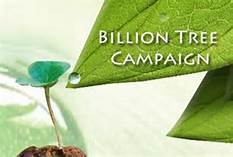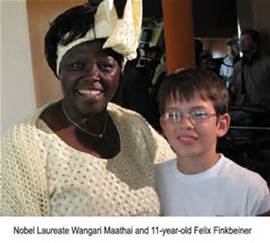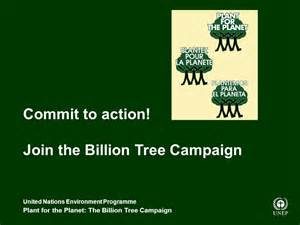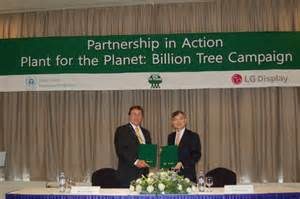From Wikipedia, the free encyclopedia 
The Billion Tree Campaign was launched in 2006, by the United Nations Environment Programme (UNEP) as a response to the challenges of global warming, as well as to a wider array of sustainability challenges, from water supply to biodiversity loss.[1] Its initial target was the planting of one billion trees in 2007 (achieved by November).[2] One year later, in 2008, the campaign’s objective was raised to 7 billion trees – a target to be met by the climate change conference that was held in Copenhagen, Denmark in December 2009. Three months before the conference, the 7 billion planted trees mark had been surpassed. In December 2011, after more than 12 billion trees had been planted, UNEP formally handed management of the program over to the youth-led not-for-profit Plant-for-the-Planet Foundation, based in Tutzing, Germany.[3] Over 14.2 billion trees have been planted as of 2016.[4] The Billion Tree Campaign calls upon all individuals, countries and companies to participate, and accepts all contributions. Planted trees and pledges can be registered here.
Inspiration
The Billion Tree Campaign was inspired by Nobel Peace Prize Laureate Wangari Maathai, founder of the Green Belt Movement.  When an executive in the United States told Professor Maathai their corporation was planning to plant a million trees, her response was: “That’s great, but what we really need is to plant a billion trees.”[5] The campaign was carried out under the patronage of Prince Albert II of Monaco.[6]
When an executive in the United States told Professor Maathai their corporation was planning to plant a million trees, her response was: “That’s great, but what we really need is to plant a billion trees.”[5] The campaign was carried out under the patronage of Prince Albert II of Monaco.[6]
“It’s the little things citizens do. That’s what will make the difference. My little thing is planting trees.” – Wangari Maathai
Response
Under UNEP’s leadership and through proactive advocacy by the patrons and the partners, the Billion Tree Campaign catalysed tree planting action on all continents. The billionth tree, an African Olive, was planted in Ethiopia in November 2007.[7] The two billionth tree took root as part of the United Nation’s World Food Programme agroforestry initiative. The campaign’s target was then raised to seven billion trees.[8] In 2009, UNEP mobilized action across the globe through the Twitter for Trees campaign on www.twitter.com/UNEPandYou. The initiative was driven by a simple yet powerful idea: UNEP pledged to plant one tree to feed into the Billion Tree Campaign, for every follower who joined from 5 May 2009 to World Environment Day on 5 June 2009. The campaign was a success, with 10,300 people following the UNEPandYou page by World Environment Day weekend.[9]
The World Organization of the Scouts Movement also planted trees under the campaign in line with its mandate to study and protect Nature across several countries.[10]
The United Nations Peacekeeping missions also joined the campaign and planted trees with its field missions in East-Timor, Côte d’Ivoire, Darfur, Lebanon, Haiti, Congo, and Liberia amongst others missions.[11]
Roll of Honour top 10 countries
- China 2.8 billion

- India 2.1 billion
- Ethiopia 1.6 billion
- Mexico 785 million
- Turkey 716 million
- Nigeria 612 million
- Kenya 455 million
- Peru 246 million
- Myanmar 191 million
- Cuba 137 million
“Around a flowering tree, one finds many insects.” – African saying
December 2011, five years since the campaign’s launch, the campaign’s website www.unep.org/billiontreecampaign proudly registered over 12.5 billion planted trees across 193 countries.
Handover to the young generation
The Billion Tree Campaign was handed over to the Plant-for-the-Planet Foundation in December 2011, an organisation that has been participating in the Billion Tree Campaign since 2007. The momentum has continued with 40,000 young ambassadors spreading the message in over 100 countries.
The momentum has continued with 40,000 young ambassadors spreading the message in over 100 countries.
Quote from UNEP
“Looking back over the Billion Tree Campaign’s greatest successes, what is most remarkable is not its scale, but its spread. People from all around the world have enthusiastically joined the campaign and planted trees in their own communities.” – Achim Steiner, UNEP Executive Director.[12]
https://en.wikipedia.org/wiki/Billion_Tree_Campaign
